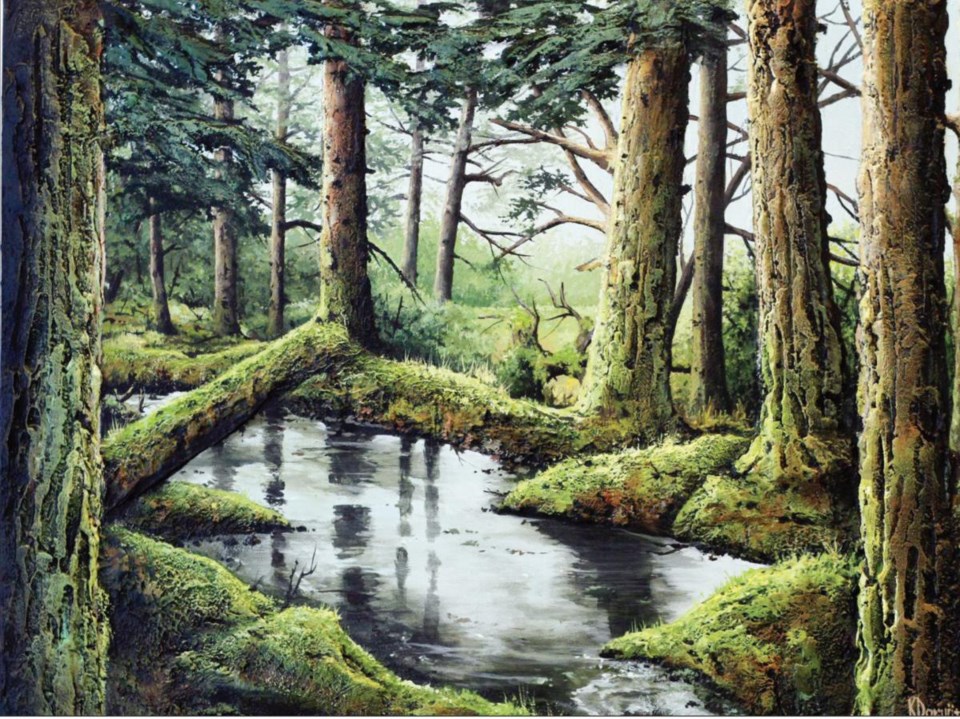"I have a theory that in this world of insecurity and change, people are looking for secure and stable images; images that set up an emotion of well-being and life everlasting."
- Karel Doruyter
More than any painter I can think of since Emily Carr, Karel Doruyter knows how to present the deep forest. While Carr's works are swaying evocations of "the juice of life," Doruyter offers us the profound and silent majesty of massive trunks and impenetrable distances.
Hung with lichens, carpeted with moss, the riven and gnarled cedars are shot through with misty light. In the current show, Doruyter takes us beyond the hand of man to the forest primeval, assembling images that speak to us on a primary level. As he has written, "Large trees are not only old but look like they will be around forever. Big trees, misty light coming through the branches, and either a path, a clearing or some body of water, remind everyone of somewhere they have been at some time. Sometimes it represents something they wish they could have seen before it disappeared."
The paintings of Doruyter don't photograph well, for they are large and, when reduced to a small photo print, they look photographic. Yet there is a third dimension that doesn't show up in reproduction. In addition to his considerable dexterity with the brush, he imbues his canvases with a surprising and haunting extra dimension. The images gently loom out into low relief, a relief the artist builds onto his canvas before he begins. There is a sense of diorama to these spaces he creates.
Doruyter begins most of his paintings by applying to the canvas what he calls the "build-up." Though there is an element of mystery about his materials and practice, in fact, as he told me, he uses a mixture of plaster and matte acrylic gel. This is thinned with water and he includes a special agent that allows it to be rigid yet somewhat flexible. The "build-up" remains workable for about 40 minutes, and he builds it up in numerous layers, laying in the shapes that will be prominent in the painting.
When it is truly dry, he sets to work on it with grinding disc, sandpaper and chisel. The deep creases of cedar bark, the random spackle of moss or smooth shafts of bare wood are recreated with deft sculptural skill. He finishes this stage with a thick coat of gesso. Then the painting begins.
Over this rough surface, Doruyter applies a dark wash that sets into the background, cloaking with shadows an impenetrable distance. He next scumbles his eloquent brushwork over the rugged surface textures, using lighter tones to bring into contrast those organic forms that would be so difficult to paint on a flat surface. The way he can bring them to life with his textured ground is uncanny.
The man and his subject, his skill and his technique are the natural resolution of Dorutyer's life experiences. Born in Rotterdam in the last days of the Second World War, he came with his parents to homestead in B.C.'s interior in 1953. A proper art education prepared him for work as a graphic artist, art teacher and book illustrator. He also discovered his passion for designing, building and voyaging in sailboats.
He has sailed up and down our coast 40 times, lived on Haida Gwaii for six years before coming to Victoria, and is a frequent visitor of the antipodes. He told me of his most recent trip, outward bound from Tierra del Fuego into the Antarctic waters on a charter sailboat. The owners of the boat had previously hired him to "redesign" it for "extreme adventures," particularly involving charters for biologists, glaciologists and climatologists.
After years of struggle, his professional career as an artist has broken through.
When, a few years ago, the Mountain Galleries in Banff and Jasper asked him to submit a piece, he sent a triptych three metres across and it was immediately sold to someone in Singapore. Since then, "they sell them almost as fast as I can paint them," he told me. "And almost all leave Canada."
With a 16-page article on Doruyter in the current issue of Arabella magazine, one can expect these brisk sales to continue.
A full complement of Doruyter's paintings is now on show at Madrona Gallery. As I mentioned before, the proper effect is not conveyed by photographs. I encourage you to go by the gallery and have a look at these remarkable paintings.
You can visit the artist at studiokd.ca.
Timeless Places: Karel Doruyter at Madrona Gallery (606 View St., 250-380-4660, madrona gallery.com) until Sept. 29.
robertamos@telus.net



